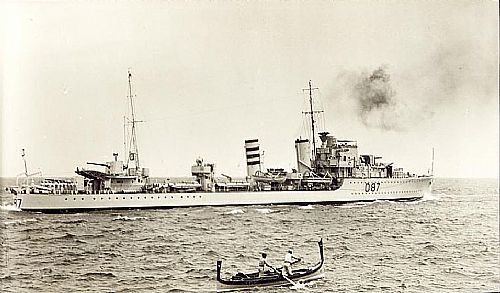Laid down 6 February 1936 Construction started 6 February 1936 Length 98 m | Namesake Isis Commissioned 2 June 1937 Launched 12 November 1936 Draft 3.81 m Operation Battle of Greece (1941) | |
 | ||
Fate Sunk by a mine off Normandy, 20 July 1944 | ||
HMS Isis was one of nine I-class destroyers built for the Royal Navy during the 1930s.
Contents
Description
The I-class ships were improved versions of the preceding H-class. They displaced 1,370 long tons (1,390 t) at standard load and 1,888 long tons (1,918 t) at deep load. The ships had an overall length of 323 feet (98.5 m), a beam of 33 feet (10.1 m) and a draught of 12 feet 6 inches (3.8 m). They were powered by two Parsons geared steam turbines, each driving one propeller shaft, using steam provided by three Admiralty three-drum boilers. The turbines developed a total of 34,000 shaft horsepower (25,000 kW) and gave a maximum speed of 35.5 knots (65.7 km/h; 40.9 mph). Isis carried a maximum of 455 long tons (462 t) of fuel oil that gave her a range of 5,500 nautical miles (10,200 km; 6,300 mi) at 15 knots (28 km/h; 17 mph). The ships' complement was 145 officers and ratings.
The ships mounted four 4.7-inch (120 mm) Mark IX guns in single mounts. For anti-aircraft (AA) defence, they had two quadruple Mark I mounts for the 0.5 inch Vickers Mark III machine gun. The I class was fitted with two above-water quintuple torpedo tube mounts for 21-inch (533 mm) torpedoes. One depth charge rack and two throwers were fitted; 16 depth charges were originally carried, but this increased to 35 shortly after the war began.
Construction and career
Isis, named for the Egyptian goddess, was laid down by the Yarrow and Company, at Scotstoun in Glasgow on 6 February 1936, launched on 12 November 1936 and commissioned on 2 June 1937. Isis took part in the evacuation of Greece in April 1941. On 19 February 1943 she and the escort destroyer HMS Hursley and a Vickers Wellington medium bomber attacked and sank the German submarine U-562 in the Mediterranean Sea north-east of Benghazi.
Isis was hit in 1941 off Beirut, Lebanon after the Battle of Crete. She pursued two Vichy French destroyers which escaped. A Junkers Ju 88 aircraft then attacked and severely damaged her. Hero tried to tow her to Haifa, Palestine. The tow rope snapped, but the engines were started and she successfully reached Haifa.
Isis struck a mine and sank off the Normandy landing beaches on 20 July 1944.
